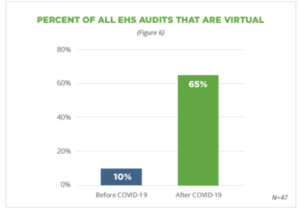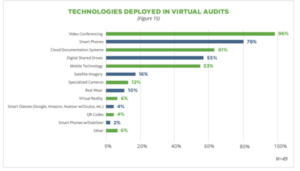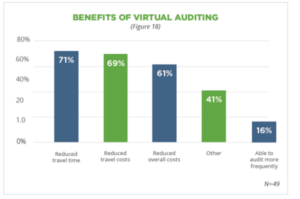The Obstacles and Benefits of Virtual EHS Audits?
The global pandemic has resulted in challenges in all walks of life. Those of us involved in auditing, auditor training and certification of management systems have had to try to overcome some of the challenges posed by remote or virtual auditing.
Widespread social distancing requirements and travel restrictions have meant that QEHS and other management system managers as well as certification bodies have had to rapidly adapt their programmes to meet their organisational objectives and effectively manage risk.
A survey done in the US by the National Association for EHS&S Management (NAEM) during the Pandemic has identified some interesting trends. Some of these trends are explored in this blog.
Fewer EHS Audits have been conducted since Covid-19 began:
The survey was carried out on large companies and the results of the survey indicated that overall there was a significant reduction in the number of audits.
On average the companies surveyed did 112 audits prior to Covid-19 and 82 after Covid-19 hit. However, another interesting trend emerged where those companies who did relatively fewer audits actually increased their audits after Covid-19.
Most companies (68%) indicated that they are currently piloting virtual audits in a limited capacity. Almost 25% of companies surveyed indicated that the use of virtual auditing is already a widespread practice.
It can be concluded that almost all large companies are planning to or are already conducting virtual audits.
Virtual Auditing has dramatically increased since the beginning of the Pandemic:
The table below (labelled Figure 6) shows the significant increase in the percentage of audits that are virtual before and after Covid-19 according to the survey.
Remote working conditions are forcing innovation in EHS auditing. Travel restrictions and the health risks of going on site as well as the lack of availability of auditors are probably the most important considerations for implementing virtual audits.
What Technologies are being Used in Virtual Audits?
The figure below (labelled Figure15) indicates that companies are using a wide variety of technology that is commonly available as a tool in virtual audits.
Video conferencing, Smart Phones, Cloud Documentation Systems are the three of the most common technologies. The scope for use of alternative and new technologies such as Smart Glasses, video and drone footage, etc is huge.
What are the main obstacles to starting a virtual auditing Programme?
There are several obstacles that have been identified as impediments to starting a virtual auditing programme. About 76% of companies feel that the results of virtual audits are less thorough or robust.
There were a number of concerns that EHS managers indicated that they had with virtual audits for example:
- Observations of facility conditions are limited to what those at the facility allow the auditor to see.
- Limitations to technology and connectivity more broadly in various sites.
- Some areas of the facility may be overlooked due to limitation of devices used or due to restriction of electronic equipment in some areas.
- When the auditor is not physically present it is far more difficult to assess a facility independent of the perspective and perception of the on-site auditor.
- During virtual audits, auditors decisions and assessments may be based on some assumptions rather than all available facts.
- The quality of results was naturally a more serious concern in higher risk facilities.
- Difficulty in training EHS staff during virtual audits.
- During in-person audits, there are opportunities for informal mentoring and coaching that are hard to replicate in a remote environment.
What are the main benefits of a virtual auditing programme?
The main benefits include reduced travel time and costs. Increased efficiency is also an obvious benefit. Examples of benefits identified in the survey are outlined in the figure below (labelled Figure 18).
Key Take-Aways:
Covid-19 has had a deep and far-reaching impact on the EHS profession.
However, along with the problems it has caused as outlined in this blog and the need for virtual audits it has also resulted in opportunities to rethink how we do audits and become more efficient.
Virtual auditing has a number of key benefits including reduced travel times, reduced costs and increased efficiency.
Innovation in the use of technology and how we conduct audits can help EHS professionals to make the best use of audits in a during and after the Covid-19 pandemic. In future blogs I will discuss the use of new technology in more detail as well as guidelines that certification and other bodies have published on virtual auditing.












